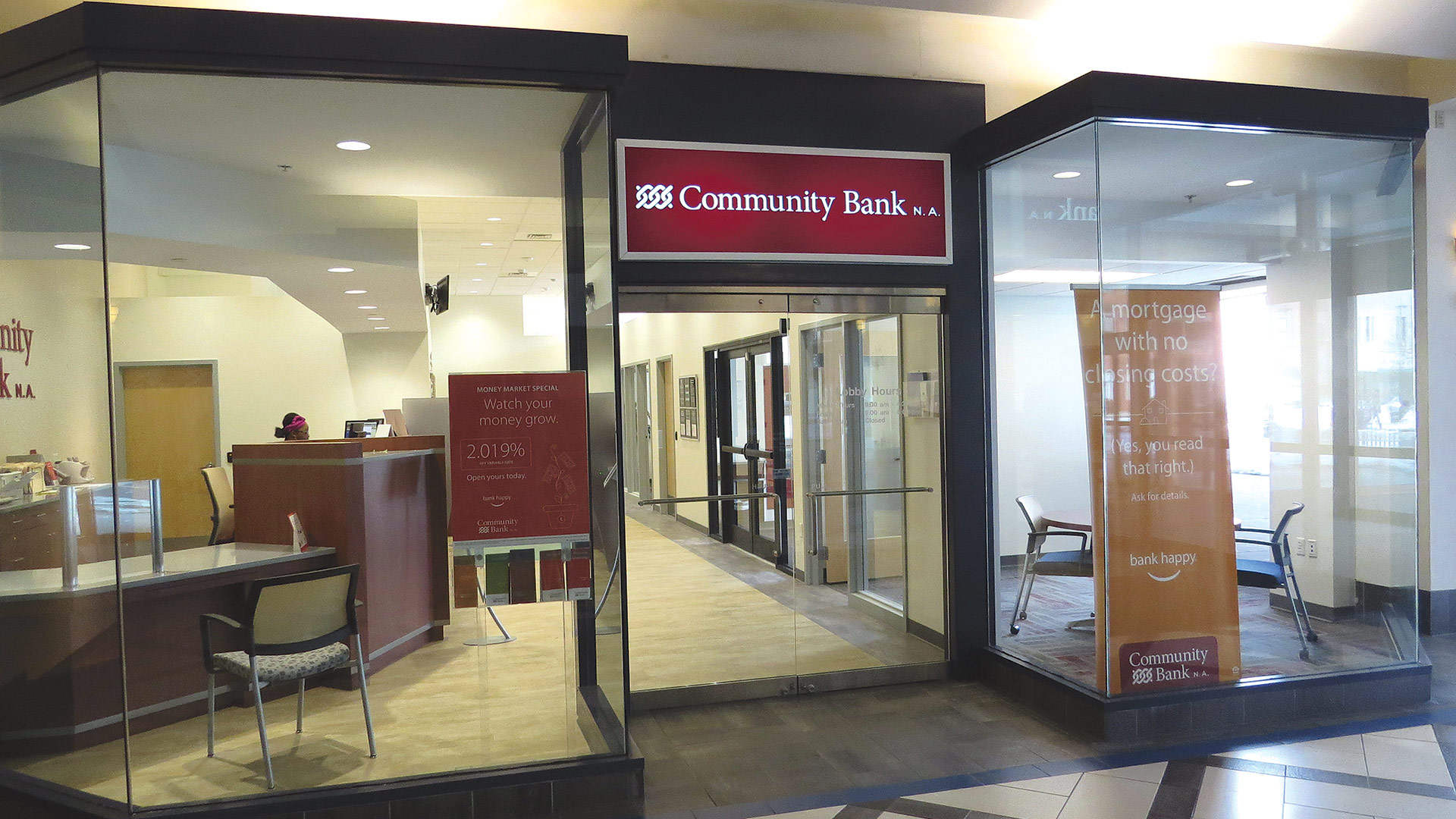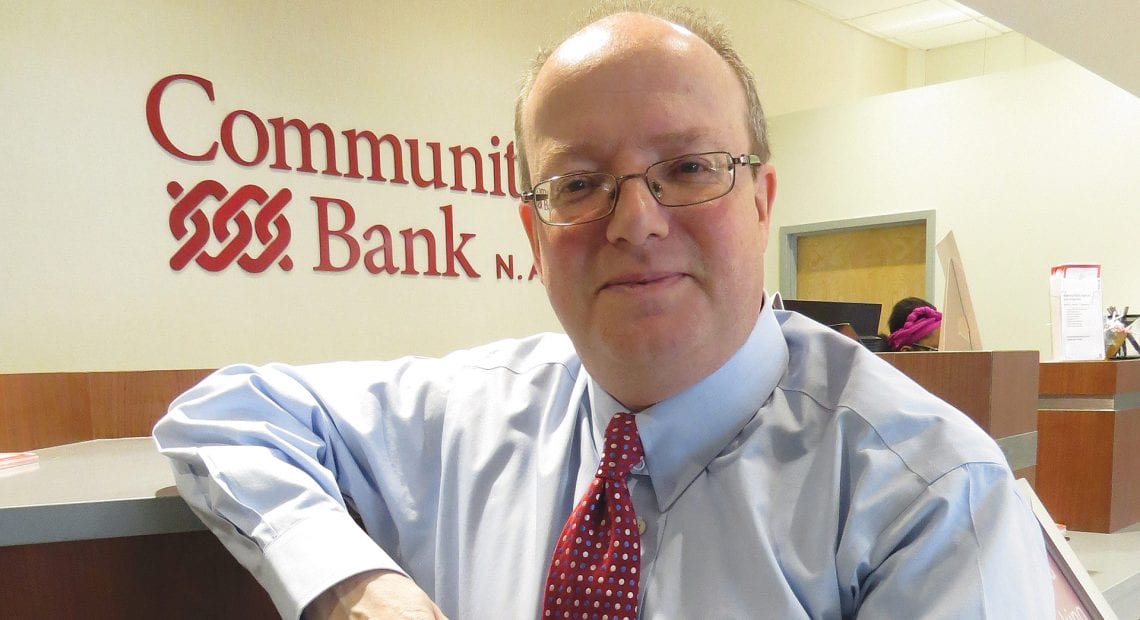What’s in a Name? Plenty

Mike Buckmaster, vice president of Commercial Lending for Community Bank, N.A.
Since entering the market in 2017 through the acquisition of Merchants Bank and its branch in Springfield’s Tower Square, Community Bank, N.A. has been working to build on its foundation in this region. It brings to the highly competitive local banking landscape both considerable size and an operating mindset commensurate with the name on the letterhead.
Mark Tryniski acknowledges that it sounds illogical that a financial-services institution with $12 billion in assets and more than 230 branches could call itself a community bank — let alone call itself Community Bank, N.A.
But Tryniski, president and CEO of the Syracuse, N.Y.-based institution, said ‘Community Bank’ represents more than a name — and one that fits. Indeed, it’s more like an attitude.
“As our name suggests, we’re a community bank — that’s how we’ve always operated,” he explained. “And when you put the name ‘Community’ on your bank, you’d better function as a community bank — and we do.
“There is such a thing as a community-bank model,” he continued. “You push authority down to people in the branches, as opposed to the big-bank model, where you walk in the door looking for a home-equity loan and they put you on the phone with a 1-800 number and someone working in another country. Community banks don’t do that.”

Mark Tryniski
“When you put the name ‘Community’ on your bank, you’d better function as a community bank — and we do.”
This operating mindset has enabled the institution to grow considerably over the past several years and into a number of different markets, including Springfield, accomplished through the acquisition in 2017 of Merchants Bank, which had previously acquired NUVO Bank, which operated a single branch within the 413 within a large footprint in Tower Square.
Since putting its name over the door on Main Street, Community Bank, N.A. has downsized that space considerably, while simultaneously working to establish itself and broaden its horizons within this market.
It has done so by essentially living up to the name over the door, said both Tryniski and Mike Buckmaster, vice president of Commercial Lending. They both said the institution possesses the formula that’s required to succeed today — a community-bank feel, but a large size that is necessary in a changing, quite challenging financial-services marketplace today.
“I think that, over a period of time, the market has accepted the fact, to a degree, that this is a consolidating industry,” said Buckmaster, who has logged more than 30 years in the banking industry, locally and in the U.K., and has carried business cards bearing the logos of NUVO and Merchants Bank, among others. “The differentiating factor tends to be the commercial banker, and if the commercial banker can continue to deliver in terms of service and business development, there tends to be a good degree of customer loyalty toward the banker, even through various acquisitions.”
That lengthy explanation helps explain why the Springfield facility has been able to enjoy steady growth in its portfolio even as the name on the wall of Tower Square has changed several times this decade.
Tryniski agreed, but said the combination of size and small-bank attitude is becoming ever more important as the consolidation movement continues without any signs of slowing down.
“I’ve been around the banking industry for a little more than 30 years, and there’s been a dramatic change in the banking landscape, mostly centered around consolidation,” he explained. “When I started, in the ’80s, there were 16,000 or 18,000 banks; now, there are roughly 6,000 banks.
“And I think the trend toward consolidation will continue because of efficiencies that can be garnered by scale and technology,” he went on. “The bigger you get, the more you can justify investments in technology to give you more efficiency. It’s hard for the smaller banks — you have to really be efficient and disciplined.”
Overall, Community Bank will look to get bigger still, and is looking at opportunities to expand within the Western Mass. and Connecticut markets, said Tryniski, but “haven’t found what the right opportunity is yet,” as he put it. Elaborating, he said growth for this institution will continue to come as it has historically, through a mix of organic growth and acquisition, with more of the latter than the former, especially in areas with slow or no growth but more than enough competition, and Western Mass. certainly fits that category.
In such markets, growth can come only by taking market share from other institutions, he went on, adding that this is generally difficult to do. Community Bank has had a good amount of success doing just that, however, because of that aforementioned enviable combination of large size and smaller-bank feel.

Mark Tryniski says Community Bank, N.A. will look for opportunities to expand locally beyond its location in Tower Square.
For this issue and its focus on banking and financial services, BusinessWest talked at length with Tryniski and Buckmaster about how Community Bank, N.A. has firmly established its presence in the local market and how it intends to secure additional market share and perhaps expand its footprint in the 413.
By All Accounts
Since acquiring Merchants, and therefore all its branches, Tryniski has visited Springfield on several occasions as part of his efforts to fully understand the broad geographic area served by the institution — one that stretches from the Northern Kingdom in Vermont to the Southwest corner of New York to the Lehigh Valley in Pennsylvania — and meet both team members and customers.
“We spend a lot of time on the road,” he said of the management team at the bank, adding that, when he does visit Springfield, or any other community served by the bank, he makes a point of learning as much about the region as he can.
In the City of Homes, he’s become familiar with some of the players within the business community, has found a few restaurants he likes, and is both impressed with and encouraged by the high level of energy he’s seeing in the central business district.
He said there are a great many similarities between Springfield and Syracuse, and in some ways, that has helped him understand the dynamics of not only the communities themselves, but the banking environment here.
“They’re remarkably similar, actually,” he said. “They have the same population, they have an industrial history, they have a stable-but-not-growing population, there’s a lot of education, the downtowns look very similar … they’re very much alike. Springfield feels to me like Syracuse.”
From a banking perspective, that means a community that, as he said, is experiencing comparatively little growth, population-wise and new-business-wise, and has a crowded field of competitors for financial-services products — banks and non-banks alike.
In this environment, operating with that community-bank model — but with roughly $3 billion in assets behind the institution — is what amounts to a competitive advantage — a large competitive advantage, said Tryniski.
“We tell our branch managers that we want them to be the president of the bank in their town,” he explained. “And we give them the authority to do that; we give them lending authority and authority around charitable contributions, fee waivers, fee adjustments, things like that. We try to vest as much authority in our branch managers locally as we can, and let them make decisions about their customers and their market.
“We probably have more of a community-bank business model than most community banks,” he went on, “because most don’t operate like that.”
However, in this market, there are still a large number of community banks — more than in many other markets — and this simple math requires that small-bank mindset. Meanwhile, the field of competitors continues to change and grow, thanks to technology, which has brought many non-bank players into the mix, said Tryniski.
“We compete now with all sorts of non-bank competitors on the lending side — for everything,” he told BusinessWest. “Whether it’s personal loans, business loans, car loans … it doesn’t matter what kind of loan you’re making, you’re competing against a multitude of other, non-banking enterprises. And the same is true on the deposit side as well.”
Buckmaster agreed, noting that, on the commercial-lending side, with all that competition, as well as all that consolidation, having a local address is not the same thing as having people who know the local market and have worked within it for years, if not decades.
“All that competition puts the emphasis very much on the banker and being able to provide the service and support growth going forward as clients need,” he said, adding that Community Bank is large and stable, and thus able to provide commercial-banking products of all sizes, including dollar amounts beyond the scope of many of the smaller community banks that populate the region.
The sweet spot for the bank, though, is loans between $1 million and $3.5 million, he said, adding that the bank is able and willing to continue writing loans for small-business owners, something the very large banks seem less interested in doing so.
This flexibility has enabled the institution now known as Community Bank, N.A. to continue to serve the customers added to its portfolio when it was NUVO, he went on, adding that loans have been written for businesses across virtually all sectors and for a number of commercial real-estate acquisitions as well.
“We’ve have some customers who were initially small back eight or nine years ago who have grown into significant customers that require a significant increase in loan support going forward,” he told BusinessWest. “We’ve seen some good growth in commercial and industrial customers over that period of time, and in addition, we’ve also seen significant new dollars in different types of commercial-investment real estate, whether it be locally in Western Mass. or further afield.”
Worthy of Interest
Returning to some of those numbers mentioned earlier — the 230 branches and current status as the 125th-largest bank in the country — Tryniski said they certainly make Community Bank, N.A. sound big. And it is.
“But we’re a lot close to the smallest bank in the country than we are to the biggest, even though the numbers say we’re one of the biggest,” he noted, adding that, in today’s banking climate, it’s not how big a bank looks on paper that matters, but how big it acts in the markets it serves.
And with that as the benchmark, this institution does indeed live up to the words on its stationary and over those 230-odd doors.
George O’Brien can be reached at [email protected]









